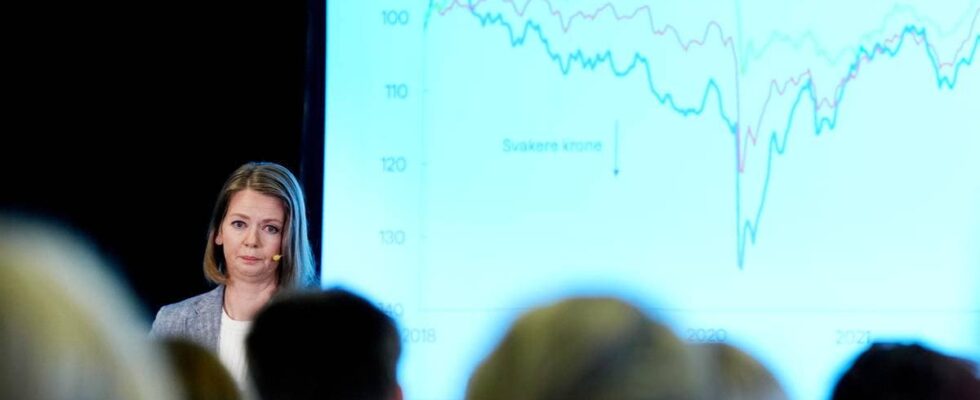There is little indication that Norges Bank is in a hurry to make the first interest rate cut. Just as expected, central bank governor Ida Wolden Bache kept the policy rate unchanged at 4.5 percent, when she presented the interest rate decision in Arendal during Arendal week on Thursday. And it seems that those longing for slightly lower interest costs will have to wait a little longer. At the previous interest rate meeting, which was just before the summer, Wolden Bache signaled that it will not happen until 2025. On Thursday, she emphasizes that the key interest rate is likely to be kept at the current level “for quite some time to come”. Before the summer, the wording was “out of the year”. Policy rate in percent The policy rate is set eight times a year by Norges Bank. The policy interest rate governs the interest rates in the banks, and affects your housing costs. The aim of raising the interest rate is for the high prices to come down again. The forecast tells us how Norges Bank thinks interest rates will develop in the future. Read more about sources and reservations here. A higher policy rate means increased expenses if you have a mortgage 2022 2023 2024 2025 2026 2027 Forecast Norges bank So what does it actually mean that Wolden Bache now says “a good while ahead”? Whether the change in wording means an earlier or later interest rate cut is not so easy to interpret. Chief economist Kjersti Haugland at DNB believes this means that the interest rate cut could come in December. However, it is not entirely obvious. A lot is at stake There are several things that are important to Norges Bank right now. Price inflation is on the way down, and ended at 2.8 per cent in July. The latest figures show that price inflation has fallen more than Norges Bank has envisaged, which is good news. This means that we are now closer to the target of 2 per cent price growth – over time. So why not just start the rate cuts immediately? The question should really be the opposite; why should she really think about interest rate cuts at all? Because even if price inflation is on the way down, the final push on price inflation may take time. It is generally easier to bring price inflation down from high levels than when you start to approach the target. Many economists are now pointing out that it is important that the central bank “stands for it”, and does not start cutting too early. – It is important that we complete the last stage. We can reap benefits from that later, said Wolden Bache, among others, during Thursday’s press conference. A premature interest rate cut could cause price inflation to turn around again, and in the worst case we could end up with an even higher interest rate than we have today. The krone pain continues In addition, the krone exchange rate has become even weaker over the summer, which means that Norges Bank continues to be stuck in the same, boring krone predicament. A weak krone means that everything we import from abroad becomes expensive, and that drives up prices. A little further down the road, the weak krone can also provide another solid wage settlement in the spring, because the export industry is going so fast. Higher wage growth could also contribute to price inflation rising again. This summer, the debate about what can be done with the weak krona has come to life again. Storebrand economist Olav Chen has, among other things, advocated several times for a so-called “dirty peg”, where the krone is controlled within a predetermined interval, according to an interview with E24 this summer. Very high threshold Wolden Bache emphasized that the threshold for intervening in the foreign exchange market is very high, and that there is little research to suggest that it works over time. So far, the large majority in the Storting have called for the mandate of Norges Bank and pointed out that it is the central bank and not the government that should have the main control over what is called monetary policy. But recently there have been new signals. Liberal deputy leader Sveinung Rotevatn has opened up about linking the krona to the euro, as Denmark has done. Conservative Party leader Erna Solberg wants a separate crown committee. It’s okay that the krone fluctuates In Arendal, however, Wolden Bache was crystal clear that she does not want a mandate change: – We have to accept that the krone exchange rate fluctuates, she said, and was also clear that she has sufficient means to solve the task. She also pointed out that although there are some costs for the krone to fluctuate, it also gives a great freedom of action in the setting of interest rates, which can therefore be adapted to the Norwegian economy. If, for example, we had tied the krone to the euro, we would also have had to follow the interest rate of the European Central Bank. Then Norway loses an important shock absorber if there is a setback in the Norwegian economy. We are not going back any further than back to the crisis years after the drop in oil prices in 2014, when it was of great importance that we could determine our own interest rate level. Right where we stand now, however, there are few signs of a crisis. There is growth in the economy, unemployment is low and everyone has received a solid salary settlement. Precisely for this reason, we cannot expect terribly many interest rate cuts in the future either. Published 15.08.2024, at 11.33 Updated 15.08.2024, at 11.42
ttn-69
It’s actually a bit strange that there is so much talk about interest rate cuts – Statement

